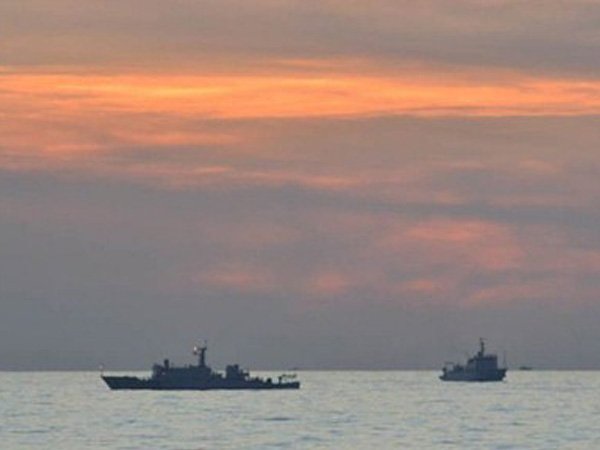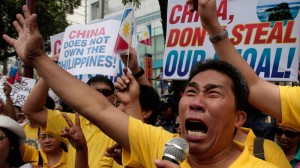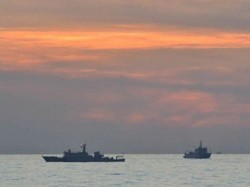
While no longer making regular headlines, the stand-off over the Scarborough Shoal/Panatag Shoal/Huangyan Island continues. Since April 10th both China and the Philippines have maintained a presence in the area, but one limited to civilian agencies – the Philippines Coast Guard on one side, and the Chinese Maritime Surveillance agency on the other.
Rather than trading literal broadsides, China and the Philippines have fought this dispute mostly through the figurative variety in the diplomatic and economic spheres. Philippines President Benigno Aquino suggested exploring joint ventures in the area and sent envoys to Beijing to attempt to resolve the crisis. China meanwhile issued travel advisories for the Philippines, halted tours, scaled back commercial flights, and quarantined incoming Philippine bananas on pest-control grounds.
Both nations have issued fishing bans on the Shoal area in the past week. The Chinese most likely issued the ban because their own fishermen will stay away until monsoon rains abate in the fall, and the stay-behind surveillance ship snow have a pretext in the ban for enforcement. The Philippines, meanwhile, supposedly issued their own ban in order to protect depleted fishing stocks, but this adversely affects the economies of local fishing communities that depend on fishing the Shoal grounds year-round to make their livelihoods.

With personal financial stability and pride at stake, it’s no surprise that civilians at times seem readier to push the situation towards a conflict than the two nations’ governments. In addition to the wide-spread nationalism (and minor protest rallies) whipped up on both sides and given voice in online forums, some 20 protestors and camera crew planned to make the case for the Philippines by setting up a protest on the shoal itself. They were persuaded by President Aquino to allow the government negotiators in Beijing a chance to achieve a constructive outcome.
Despite what my colleague believes about the benefits of the U.S. sitting on the sidelines of the U.N. Convention on the Law of the Sea, the Scarborough Shoal stand-off is an apt example of how not having ratified the treaty can hamstring the U.S.’ ability to bring pressure to bear on another country (China) for failing to live up to its treaty obligations in pursuance of a peaceful and diplomatic resolution. For while the Philippines is building a case for the International Tribunal for the Law of the Sea (ITLOS), one of the UNCLOS conflict-resolution mechanisms, China, another signatory, refuses to abide by any rulings of the tribunal.
With the stand-off as a backdrop, both sides are expanding their naval forces. The Philippine navy is set to take possession of another U.S. Coast Guard vessel Tuesday, the ex-USCGC Dallas, of the same type as its current flagship, the BRP Gregorio del Pilar. The Chinese Maritime Surveillance administration is also rapidly expanding in numbers (h/t Chuck Hill – CGBlog.org). This is the agency that intervened at the Shoal and prevented the Philippine navy from arresting the Chinese fisherman whose discovery began the current stand-off. While a nation with an expansive coastline and far-flung fishing interests has legitimate needs for a competent coast guard, the continuing Scarborough Shoal stand-off is just one more illustration that ships of this agency are enforcers of state policy, and Chinese maritime state policy has been rather uncompromising of late.


From a tactical perspective, it will be difficult for the RP CG to maintain presence. As I mentioned in the discussion at ID, the Del Pilar is the first vessel the nation has had in a while that has the range , speed and material condition to be able to steam quickly to a crisis in the Western Sea. All other assets will be hard pressed, and rotating on and off is hell on 40+ year old ships that are long overdue for a yard refit. What’s really been needed besides vessels is a closer operating base for the Spratleys – the Southern End of Palawan is a perfect location for port facilities as well as a smaller airstrip to facilitate more persistent ISR. The rest of the crisis is simply diplomatic tit-for-tat.
In a general way, the CMS now becomes a defacto naval militia – although configured and publicly marketed as a fisheries-enivornmental police/SAR force, it now gives the one thing that a naval force needs to patrol a large area – persistent, networked presence. The number of CMS ships already afloat rivals many of China’s neighboring navies. Each one of them, even lightly armed, can provide intel and a bit of the neighborhood bully effect. If they run into a larger foe, it’s simple enough to whistle up some PLAN assets to keep the pressure on. Quantity is a quality all it’s own…
True, the logic of forward basing holds true whether on the global scale of the U.S. navy or the localized, regional scale of the Philippines. It looks like not everyone would be happy with a base on Palawan, however, especially if it played host to American forces: http://www.philstar.com/nation/article.aspx?publicationsubcategoryid=200&articleid=785052
Another option would be expanding the seaport on Pag-asa Island. Although it’s a bit small for a large build-up, it could station some small vessels contributing to the persistent, networked presence you spoke of:
http://thehill.com/blogs/defcon-hill/army/219717-reports-us-philippines-building-new-naval-base-in-spratlys-
Looks like the PCG finally got funding to establish a Western-facing log-base. It would be useful as well to the Navy and Air Force if it can accomodate small aircraft. The big challenge besides transit time to the hot zone in the Spratleys and shoals is the sheer range. For smaller aircraft, there’s not a lot of landing zones from which to conduct a tactical refuel or provide emergency divert options.
Philippine Star News: Western Philippine Sea Base to be Built for Coast Guard